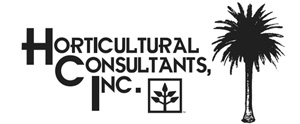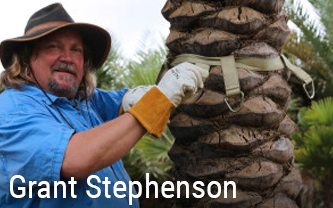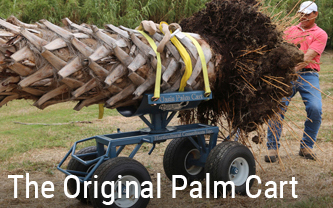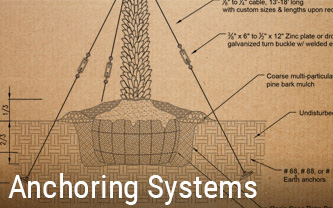Welcome to WordPress. This is your first post. Edit or delete it, then start writing!

Translate:
Office: 1-713-665-7256
Toll Free: 1-800-460-PALM(7256)
Archive for Uncategorized
Contracting the services of a horticultural consultant may well be one of the best routes to go for people, organizations, or commercial entities who wish to protect their investment and ensure their plant project continues to thrive.
Industry experts can contribute to the growth and propagation of flora in a number of ways. This is especially true when considering the installment of one or several palm trees – a notoriously fickle tropical plant that exhibits special needs that require in-depth knowledge to meet. Grant Stephenson and his company Horticultural Consultants Inc. is one of very few companies in the United States that specializes solely on palm trees and less than a handful of other tropical plants. The company has made the cultivation, handling and research of palms its center of expertise
Some of the services clients should expect from a professional advisor and the company’s third-party associates include.
- Assistance in choosing the proper plant species to enhance the beauty of the premises, while considering all aspects of survival and prospering
- Quality plants, preferably grown in-house or in the field to assure the best possible condition and appearance
- Expert handling of plants at the originating location, in transit and at the destination site to minimize trauma and injury to the specimen
- Tips on how to care for the plant and in-depth consultation regarding fertilization, pest control and other issues that may affect the plant’s health
- Ongoing customer service and availability to answer questions or address concerns
Horticultural consultant Grant Stephenson and his company are prepared to meet all the needs of the client, as well as those of the tropical plant of choice.
Hire a Horticultural Consultant for the best landscaping choices
Hiring a horticultural consultant is an excellent decision for someone that wants to make the best landscaping choices. The services they can provide are valuable to homeowners, businesses, and botanical gardens. They assist with planning and design, but the decisions that they can advise on cover more than the appearance of a lawn or garden. No one wants to waste money on a plant that is so ill suited for the local climate that it dies. A consultant will apply their knowledge of flora to assist in finding the right matches for the amount of shade, type of soil, and climate patterns.
The plant life that is already situated in a lawn can benefit also, by being properly identified. The identification of flora can lead to appropriate care. This may cause plants that were previously receiving the wrong treatment to thrive and flourish. They can create a watering schedule that is best for the plants, and offer advice on irrigation methods. Harmful infestations can be avoided and treated with the help of these horticulture experts. They are capable of creating a management plan to handle both pests and diseases.
A horticultural consultant is an invaluable asset when trying to add to the local scenery. Their experience is useful for choosing the species that can prosper in that area. While palms are commonly associated with more tropical climates, they do have variations that are able to stand up to colder weather. There are a variety of species that are cold weather hardy, but that does not mean that they are interchangeable. A consultant, with their knowledge of floriculture and the pathology of plants, can offer informative facts about which palms are the best suited to the area.
Root protection and regeneration are two of the most important aspects of moving a palm tree. These plants, when relocated to another landscape, go through a physical shock due to soil, temperature and sunlight changes. The palm tree is entirely dependent on its roots, so extra precaution must be taken to ensure that the plant will survive the move.
Their roots, like the roots of grass, are small, intricately tangled and well developed. Disturbances, such as digging or cutting, must be put off until the trunk begins to show development. Root regeneration varies from one type of palm to the next, but it is important that the root ball is properly protected from any exposure. They need to be wrapped in a tarp and kept moist. The dirt ball must be at least 1 foot in diameter more than the root ball to increase the survival chance. Movers must keep the plant properly supported as well. Moving a palm tree requires nylon slings, rather than chains, as their bark is particularly sensitive. Upon reaching its new destination, it must be either planted immediately or kept in the shade and wet.
One should never plant a palm’s trunk deeper than it was in its previous setting. If it is planted too deep it will cause root suffocation, so it’s better to let the tops be uneven. When relocating the plant, the fronds need to be tied, and the older leaves removed. Once back in the ground, the plant can have its leaves untied, and a soil barrier put around the root ball to retain necessary moisture levels. The best time to move this type of plant is either in the spring or summer.
An Oasis palm tree anchoring kit is an important part of successfully transplanting new palm plants. The Arecaceae botanical family is a popular choice for temperate climates. However, the plants are quite fragile once transplanted. Without the proper security the plant will not thrive, often dying. Some of the plants are rare and endangered, and the price can be steep for a single plant, so it is worth protecting the investment.
The patented system is unique, and the easy to follow instructions make it simple to use. The materials used in the construction are all high quality and reinforced to guarantee better results. But what exactly comes in a palm tree anchoring kit?
The belt, or collar, fastens around the trunk of the plant. It is secured with either a cam or ratchet buckle locking mechanism. The collar has three or four D-rings attached with reinforced loops. The number of loops is determined by the size of the system. It is also a natural color, so it camouflages easily into the surroundings.
The D-rings attach to the loops and the cables. The cables thickness depends on the system, and the length is commonly between 13 and 18 feet. However, the length can be customized upon request. The cables have turnbuckles in the middle to make it easier to adjust the system with plant growth.
Finally, the cables attach to four foot drive rods that go deep into undisturbed earth. The drive rods are not visible once in place, and they secure the plant safely to the ground, enabling them to withstand heavy wind and rain. The virtually invisible system is an invaluable resource that maximizes the plant’s chances of surviving the transplant.
I recently returned from a Board of Directors meeting for International Palm Society in the Amazon region of Peru. This is one of the most biologically diverse areas in the world, or in other words, Nurseryman’s Heaven. And now, getting back to life in the nursery and going through my emails, I came across an interesting question. <strong>I was sent a photo of a seedling that I was asked to identify. Here is the question and my answer–it seems to be a common question.
Help! I can’t find anyone who can tell me what kind of palm seedling I have.
The short answer is that it is a Heinz 57!
The seedling that was in the photo attached to the email appears to be a seedling of the true editable date palm. It seems to have a fairly full head and gray green foliage which is characteristic of the species. I say palm seedling as the only way to get a specific species cultivar is to plant an offshoot from a mother plant.</strong> You can see the characteristic pups coming up from the base of this one. These could be harvested and you could keep this plant’s particular genes growing. As to the cultivar, nobody knows.</strong> When you plant a seed you never know where the pollen came from and therefore you never know what you have as the genus is somewhat promiscuous in cross pollinating. There are hundreds of cultivars of phoenix palms and unless you hand pollinate or cut and transplant offshoots there is no way to know what its antecedents are.
At times, landscapers may find it necessary to thin vegetation. Perhaps the plant is not thriving as it should and a new location may be deemed advantageous. Nurseries and harvesters, by definition, must constantly transplant trees from their original stand to the customer’s premises.
While the plant’s compact root ball makes palms a great candidate for transplant, it is also imperative that handlers unearth the plant carefully. Generous wetting around the base of the plant, for example, ensures that as much soil sticks to the root ball as possible, which in turn facilitates the plant’s acclimation at the new location. Burlap may also be required to keep the specimen moist during transport.
A palm cart is recommended for hauling the tree to the transport vehicle to ensure the most effective and safest handling possible, with minimum trauma to the plant. Avoiding stress is important to decrease the weakened plant’s susceptibility to pest infestation. Braces and splints are often needed to ensure top-heavy species do not snap from the weight of the crown, and extra care must be taken to protect the plant’s heart and bud at all times. The plant’s leaves (and possibly stem clusters) should be tied together to avoid injury.
At the destination, handlers must transplant the specimen at the same depth at which it grew initially in an effort to maximize the chance for the plant’s survival. The root initiation zone’s extreme sensitivity can lead to the death of the plant if it is buried too deeply.
The complexity of moving palm trees often calls for the help of industry experts who are experienced in handling these tropical plants.
P.O. Box 596
Spicewood, TX 78669
Toll Free: 1-800-460-PALM(7256)
Drawings and detail sheets are conceptual only. There are no expressed or implied warranties or guarantees.
![]()







